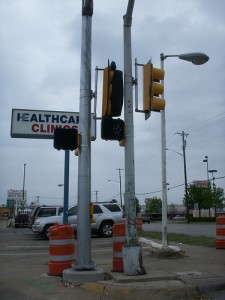 RSS FEED
RSS FEED
Archive for the ‘Medicine’ Category
Childrens’ Health Insurance Plans Sometimes Cover Parents Too
October 30th, 2008

If you saw my recent post on our family’s Health Insurance Headaches you know I’ve been doing a lot of research into health insurance options lately. I thought I’d pass on some information that might help some of you. In the United States, every state and territory provides low or no cost medical insurance coverage to uninsured children under a federal initiative called the State Children’s Health Insurance Program (SCHIP). The program is paid for by both the Federal and State governments, but each state administers its own program, including (within Federal guidelines), determining eligibility, benefits, and payment levels.
The program was originally designed only to cover children, but has been extended to the parents of eligible children by a number of states. In my state parents of children 19 and younger can qualify for free coverage if they are under a certain income guideline, and for those earning slightly more there is a sliding scale of premiums. Some other states may require the parents to be already receiving public assistance or Medicaid. I mention it because it is worth checking your state’s rules. So many people are temporarily out of work or their business has declined or other factors leave them unable to afford the insurance they once could.
I hope a few of you reading this are helped – or know someone else who could use this information. I know it’s no help to those of you who don’t have children, or whose children are grown, or who earn too much but still can’t afford good health insurance. I hope we have a better system soon! If you live outside the US, I hope you live in one of those sensible countries with universal health coverage!
– Megan
Healthcare clinic image courtesy of Daniel Lobo.
Tags: health insurance, healthcare, State Children's Health Insurance Program
Posted in Current Affairs, Medicine | Comments (0)
Is the Economy Hurting your Head?
October 27th, 2008
As you know from my recent posts, the costs of health care and our national tragedy of a broken  health insurance system have been hitting me where I live lately. Of course I’m far from alone in this. In the current economic crisis, people are finding it harder than ever to afford the medications and health care they need. In a study published on October 14, the National Headache Foundation (NHF) surveyed 270 headache sufferers on line recently, and found that more than three quarters of the respondents said they have cut back financially, and those cuts have impacted their headache treatment:
health insurance system have been hitting me where I live lately. Of course I’m far from alone in this. In the current economic crisis, people are finding it harder than ever to afford the medications and health care they need. In a study published on October 14, the National Headache Foundation (NHF) surveyed 270 headache sufferers on line recently, and found that more than three quarters of the respondents said they have cut back financially, and those cuts have impacted their headache treatment:
Migraineurs are not alone in this, of course, the New York Times reported last week that prescription drug sales are down, and people are cutting back on life saving medications for many medical conditions. The NHF’s survey also found that people were cutting back on certain types of food purchases, and were not sleeping as well and feeling more stress due to their economic situation. Sleep disturbances, anxiety and dietary changes were all cited as triggering increased headaches. Delaying or skipping filling prescriptions, or using over the counter medications as a substitute is a serious concern. It’s easy for me to say to you – don’t cut back on prescription medications! Find something else to cut back on! If the choice is between snack foods and prescriptions, definitely give up the snack foods. Unfortunately, many of my prescriptions have a $50 co-pay. I could save a lot more money delaying a $50 co-pay than going without a $3.89 box of donuts. Sometimes we are faced with real, terrible choices. Sometimes we have to choose what to do without, and there may be no truly right answer. I will not presume to advise you here – you must make your own choice. Some economic insecurity is very real. Some people lose their jobs, can’t get loans, lose their investments, don’t have health insurance, and have to make terrible choices. Please ask yourself whether you really need to forgo this expense, or whether it is just anxiety and fear for the future that is making your decision for you. The NHF has some suggestions for ways to afford your prescriptions:
- If you are unable to afford your medication, many pharmaceutical companies offer patient assistance programs. Talk to your doctor or visit the NHF Web site (www.headaches.org) and click on Headache Education-Tools for Sufferers for a list of available programs.
- Talk to your doctor about your financial situation; there may be a generic form of your prescription available.
 Beyond the nuts and bolts of paying for the prescriptions, though, you need ways to manage your stress and anxiety. I suggest snuggling a kitty if you can. NHF has some good advice, picking up on some familiar themes here at Free my Brain, they suggest you practice relaxation techniques and include exercise in your daily routine. Suzanne Simons, NHF Executive Director, concludes with a great piece of advice: “remember that the financial turmoil we are currently experiencing is temporary. …[T]he situation will get better and keeping a positive outlook may help lessen the emotional and physical impact of these volatile economic times.” Remember that economies are affected by attitudes. Refuse to give in to despair. Do whatever you can to make things better. And get out and vote for change!
Beyond the nuts and bolts of paying for the prescriptions, though, you need ways to manage your stress and anxiety. I suggest snuggling a kitty if you can. NHF has some good advice, picking up on some familiar themes here at Free my Brain, they suggest you practice relaxation techniques and include exercise in your daily routine. Suzanne Simons, NHF Executive Director, concludes with a great piece of advice: “remember that the financial turmoil we are currently experiencing is temporary. …[T]he situation will get better and keeping a positive outlook may help lessen the emotional and physical impact of these volatile economic times.” Remember that economies are affected by attitudes. Refuse to give in to despair. Do whatever you can to make things better. And get out and vote for change!
– Megan Oltman
Hand on head image courtesy of Mr. Thomas/Christopher.
Tags: economy, migraine, National Headache Foundation, prescription drugs, relaxation
Posted in Communicating, Current Affairs, Managing, Medicine, Tips & Techniques | Comments (3)
Migraine Preventive Medication: Move it on up Slowly
October 24th, 2008

Most medications in use for Migraine prevention have a number of side effects, and many, if not most, migraineurs are sensitive to medications and their side effects. Topamax, which I am currently using, is used successfully by many and considered to have intolerable side effects by others. Some months ago I read Teri Robert’s report on Dr. Stephen Silberstein’s (of the Jefferson Headache Center) recommendations for a gradual increase (titration) schedule on My Migraine Connection. You can read Dr. Silberstein’s Topamax Recommendations
here, regarding how to slowly increase the dosage. He observed that “proper dosage and titration (tapering up the dosage) is essential for successful use of Topamax.”
Being naturally rather suspicious of medications, I went into my headache specialist with this information, and asked that we titrate slowly. I was pleased to discover that Dr. Gerhardstein takes an even more cautious approach than I do. At this point I have been on the minimum dosage for about a
month. I saw Dr. G in New Brunswick again this week and he
wants me to have an eye exam to rule out glaucoma before increasing the
dosage. I have that scheduled for next week. Assuming that exam result
is okay (no reason to think it won’t be), I will go to 50 mg daily after
that.
I asked Dr. G about instituting an increase schedule after that point and he told me
he doesn’t want to go on a regular weekly or bi-weekly increase
schedule because it is easy to “blow right past” the minimum effective
dose that way. He said he thinks many incidents of intolerable side effects
may be from being on too high a dosage. The plan is for me to try each
increased dosage for about 3-4 weeks and then call him to discuss. He
wants me to keep a detailed diary and stay very aware of my body’s
reactions.
I really like this approach. I know we are all
impatient for results, no one wants to stay in pain and with the
disruptions of frequent Migraines. But I think this way I can minimize
side effects and have the most control and awareness over what is
happening in my body. If more side effects are experienced on higher dosages, and we could end
up on a higher dosage than we need by not giving each level a long
enough try, maybe a very slow titration increases our chance of finding the
level that is optimum for each of us, with the best balance of Migraine
prevention to side effects. In the meantime, we can be listening carefully to our bodies and observing their reactions.
– Megan Oltman
Ocean daybreak image courtesy of Hideyuki Kamon.
Tags: Dr. Brian Gerhardstein, Dr. Stephen Silberstein, Migraine preventive medication, Topamax
Posted in Medicine | Comments (0)
Testing for Medication Allergies
October 13th, 2008

Long story ahead. I’ve been trying to get tested to get more information about the specifics of my medication allergies. I’m allergic to ibuprofen, likely all aspirin derivatives (NSAIDs) and possibly also acetominophen. Long story which you may have read here, 2 near-death anaphylactic reactions to Advil, hives from Tylenol, swollen lips from an aspirin-based product, yada-yada.
My allergist suggested at the time (nearly 6 years ago) that since all these reactions happened within a few months, when my system calmed down I might not be allergic to everything. But said allergist would not do challenge tests on me for the medications for fear of liability, and she was also a screaming nasty unprofessional person whose sorry butt got fired.
Lo, 5+ years of living without these meds later, my headache specialist would like me to get tested for aspirin and acetominophen to see if we can expand my available Migraine medication options. My primary doctor told me 6 months ago that he thought he could do such a test in his office. The idea would be that I would actually ingest a small controlled amount of the drug in question and the staff would stand by to save me if I started going into anaphylaxis. Sounds like fun, no?
So last week I went to talk to my primary doctor about doing said challenge tests in his office. He
 discussed it with me in more detail. He wanted to find a less dangerous way and proposed testing my blood for antibodies to the chemicals involved. This indicates whether there is a sensitivity, but I asked him, “Does having a sensitivity tell you whether the body would react anaphylactically?” He went off to research it and concluded that no, it wouldn’t. I just got
discussed it with me in more detail. He wanted to find a less dangerous way and proposed testing my blood for antibodies to the chemicals involved. This indicates whether there is a sensitivity, but I asked him, “Does having a sensitivity tell you whether the body would react anaphylactically?” He went off to research it and concluded that no, it wouldn’t. I just got
a call back from his nurse saying there was no way to test except the “old-fashioned” challenge test, and they felt that could only be done in the hospital with a crash cart. So I should find an allergist who would admit me as an inpatient and do the test in the hospital.
Is this back to square one? I’m imagining calling allergists’ offices and saying, “hi, I’m looking to make an appointment see if the doctor would be willing to put me in the hospital, give me something that might kill me and then stand by to save my life! Oh and by the way, I really am counting on my life being saved! Want to take me on as a patient?” The fact that I am about to switch insurance makes this all more complicated.
I’m actually going to call Dr. G (headache specialist) and see if he might think
an allergist associated with his hospital would do it. At least then it would be one doctor asking it of another instead of some crazy-sounding patient?
I’m not particularly upset here or anything, just kind of rolling my eyes. Nothing’s ever simple, is it? It’s a wonder any of us ever have time to do anything other than wade our way through our medical issues!
– Megan Oltman
Still living aspirin-free!
Aspirin image courtesy of Ritcharnd Moskow; magic pill image courtesy of [O*] ‘BharaT; map-maze image courtesy of David Bleasdale.
Tags: allergy challenge test, aspirin, headache specialists, ibuprofen, medication allergies, Migraine treatment, NSAIDs
Posted in Medicine, Rant | Comments (3)
Topamax Trials
October 8th, 2008
Just a quick update on my trials of/on Topamax. No tribulations so far, knock wood (picture me
 knocking on my head.) I’ve just finished my third week on the minimum dosage. This is too soon to tell whether it is working as a preventive. I have had 5 Migraines in those 3 weeks – which is on the low side of average for me, but three weeks is not a good sample – any given three week period could be better or worse. More to the point I may need a higher dosage for full effectiveness, and the medication takes some time to build up in the system.
knocking on my head.) I’ve just finished my third week on the minimum dosage. This is too soon to tell whether it is working as a preventive. I have had 5 Migraines in those 3 weeks – which is on the low side of average for me, but three weeks is not a good sample – any given three week period could be better or worse. More to the point I may need a higher dosage for full effectiveness, and the medication takes some time to build up in the system.
Topamax is an anti-seizure medication, originally developed for the treatment of epilepsy. Its Migraine preventive effect was discovered in some epileptic patients who were also Migraineurs. It is currently one of very few medications actually approved by the FDA for Migraine prevention, all of them originally developed for other purposes. There are 100 other medications that have been effectively used to prevent Migraines; Topamax is not the only game in town. It may be the first some doctors try, since it is fairly well known, but unfortunately also has a high side-effect profile. For people who are sensitive to medications, as are many Migraineurs, this is a dilemma.
Typically people feel tingling in their fingers and toes, less often in the lips and other places. I emailed my doctor after about a week on the stuff when I was having intense itchy tingling in my lips and nose, tongue and TEETH (who ever heard of itching teeth?),
top of my scalp, behind my ears, my kneecaps, elbows, ankles, tops of
my fingers, outsides of my thighs, shoulder blades, upper eyelids. It
kept waking me up one night. I was worried that this might be an allergic reaction. Dr. G emailed back that unless there was a rash, it was probably not a problem. I had no rash and the tingling disappeared the next day.
The other side effect I was most concerned about was mental cloudiness. Some people have reported so much mental fog and forgetfulness that the drug has earned the nick-name Dopamax! I’ve had a little trouble with finding the right words, but that seems to be passing. I’ve found that my ability to multi-task, or keep a sequence in my mind is somewhat impaired. I have to concentrate harder, write  more lists since my ability to make a mental list is less than usual.
more lists since my ability to make a mental list is less than usual.
I’ve been pretty sparse with the posts here the last few weeks and I put that down to adjusting to the new medication. I am lucky that I’m not spacier still. After nearly 50 years you get used to the way your brain works, and to find your thinking change is a big adjustment. It’s like re-routing around road work. I’ve always had a good internal GPS system, but these days I have to pull out a map. And check it again every few minutes.
– Megan
Block head image courtesy of Stefan; road work image courtesy of Hubbers.
Tags: mental cloudiness, Migraine preventive medication, Topamax
Posted in Medicine, Musings | Comments (2)
Between a Rock and a Hard Place – How do We Choose?
September 19th, 2008
The first in a series of posts on Migraineurs making choices for our health care and our lives.
How do we choose? We are faced with choices on a daily basis. We lose sleep over them; they feel momentous, life-changing. Rarely are they an Indiana Jones moment:
- if I step on the wrong step it will crumble below me and hurl me into the rat/snake/cockroach infested pit, or
- if I stake all on drinking from the gold cup my eyeballs will melt and I will desiccate into a human husk, so that the 2000 year-old crusader can say “he chose unwisely.”
Most of our choices change our lives more gradually!
For those of us with Migraine disease and chronic illness, choices often revolve around
- what treatments to try, and
- how to manage to make our living.
Most choices in life are reversible; we can change our minds, have a chance to learn from our mistakes. Usually there is no one clear right choice. In medical situations we often wish there was one. How about the doctor coming to us and saying, “Well, Ms. So and So, here’s the choice
1. If you take this course of treatment it will cost you $2500 and you will feel worse for 2 months, 3 days and 16 hours, but then you will lose 30 pounds, become a natural blond, your Migraines will cease  forever and you will never age another day.
forever and you will never age another day.
2. On the other hand if you don’t take the course of treatment your fingers will gradually turn to pretzel sticks and crumble away, your brain will become a giant chicken heart and eat Philadelphia, your best friend will never speak to you again, and you will have a Migraine every day forever.”
I don’t know about you, but I’d go for the treatment. And I don’t even want to be a blond!
Okay, I’m being extreme. I hope I didn’t lose you there in all my silliness; there really is a point. It is rarely given to us to know whether we are making the right choice, before, during, or after. We have to weigh our options, but then we just have to choose.
Before I had my first child I fell and herniated a disk in my low back, causing two years of back pain. Then I had a difficult labor with an erratic pattern of contractions, wearing me out without making progress. After 18 hours of labor, I chose to use pitocin, a synthetic hormone, to stimulate the labor, and the pitocin made the contractions strong and painful enough that I felt I needed anesthesia. I had to choose between taking pain-killers and having an epidural (where anesthetic would be injected into the dura, or sack, around my spine). With an epidural there was a chance that my disk problem could become worse, even to the point of permanent back pain. With pain-killers, if I ended up with a cesarian section, I would need general anesthesia. The choice was to be awake for my daughter’s birth and risk disabling back pain, or to risk being knocked out for her birth with no back complications. I chose the epidural. I did have a cesarian; I was awake; and I did not develop any back problems from it.
My husband and I will never forget when I was lying in the birthing chair, pitocin-induced contractions sending me into ever higher spikes of pain and exertion, trying to make a choice in the panting moments between. We were 31 years old, and we felt like we became adults in that moment. If I had ended up with disabling back pain, I don’t know if I would have said it was the right choice. To be awake and hold Rachel in the moment after she came into the world was a joy I did not want to miss. That was what I chose. But who can say if it was the right choice?
The choice I made recently was to start on Migraine preventive medication. I spent at least 6 months making that choice. It was a choice I was considering for at least 4 years. Sometimes a choice needs to stew on the back burner of our minds. In that 6 months I:
• Found a doctor I could trust (which took several tries and months of waiting for appointments);
• Did a lot of on-line research, and read about other’s experiences with preventives;
• Recommitted to my meditation and relaxation program;
• Tried magnesium and B2 supplements;
• Tracked my Migraine numbers; and
• Talked about the decision with my friends on and off line, my husband, my family.
Eventually, the choice just felt clear.
I will be returning to this subject of choosing in several more posts in the near future – if you’ve read all the way down here I’ve kept you too long already! What I’ll leave you with today is to say that those times when you must make that life-changing decision right now are rare. We usually have some time to make our choices. Use that time. Let things simmer on the back burner. Let your subconscious mind do its job. Will you make the right choice? Nobody knows. But you can make the choice with much less anxiety in the meantime.
– Megan Oltman
Pretzel sticks image coutesy of Windell Oskay; image of window at Mesa Verde is by me to illustrate being between a rock and a hard place – Mesa Verde is all rocks & hard places. And amazing.
Tags: childbirth, chronic illness, Indiana Jones, making choices, Migraine disease, Migraine treatment, pitocin
Posted in Managing, Medicine, Silliness | Comments (7)
Blog Carnival – Improving Doctor Patient Communication
September 9th, 2008
 Just in time for my Migraine specialist visit next Tuesday, Diana Lee has posted the September Headache Blog Carnival – Tips for Improving Doctor Patient Communication over at Somebody Heal Me. I’m going to have a lot of reading to do!
Just in time for my Migraine specialist visit next Tuesday, Diana Lee has posted the September Headache Blog Carnival – Tips for Improving Doctor Patient Communication over at Somebody Heal Me. I’m going to have a lot of reading to do!
Generally speaking, a blog carnival is a collection of links to a
variety of a blogs on a central topic. The Headache & Migraine Disease Blog
Carnival has been created to provide both headache and migraine
disease patients and people who blog about headache disorders with unique
opportunities to share ideas on topics of particular interest and importance to
us. Visit the link to this month’s carnival for a collection of
informative entries on improving doctor patient communication.
– Megan Oltman
Tags: blog carnival, doctor/patient communication, headache, Migraine disease
Posted in Medicine, Weblogs | Comments (0)
When is it Time to Use Migraine Preventive Medication?
September 6th, 2008

When is it time to use Migraine preventive medications? It has been a difficult decision for me, as it may be for many of you. There are clear medical guidelines, and recent research that backs them up. And yet it is not an easy step to take.
3 or more Migraine attacks per month
Headache specialists will generally prescribe Migraine preventives if you have 3 or more Migraine attacks per month. My HA doctor told me his guideline is one per week, on average (which sounds very much like 3 or more per month). If you think about it, a Migraine every week, or nearly every week, is a threshold level for having a serious disabling impact on your life. Every week you will lose hours or a day or more to pain, photophobia, nausea, whatever package of symptoms you tend to have. You will miss work, family time, social time. You will waste hours in a darkened room.
Silent Brain Damage
There’s more to it than the impact on our daily lives. Recent research shows that Migraine attacks at a frequency of 3 or more per month, over an extended period of time, leads to brain damage. The evidence is now very strong that Migraine is a progressive brain disease; it worsens over time. The more frequent, and longer time since onset of Migraine attacks, the greater risk of damage. The damage shows up as lesions in the white matter of the brain. The researchers called it “silent brain damage” because there are no known effects of this damage – yet.
Teri Robert, author of Living Well with Migraine Disease and Headaches, discussed the implications of this research in her recent article on My Migraine Connection, “Yes, Migraines can Cause Brain Damage.” Teri gives us an excellent explanation of the research, concluding that:
Migraineurs who experience frequent Migraine attacks and / or have a long history of Migraines are at increased risk of “silent brain damage,” brain damage that (so far) does not seem to cause any symptoms. This again shows that reducing the frequency of Migraine attacks (aka Migraine headaches) is critical.
So why wouldn’t you go on preventives?
I have averaged 7 Migraine attacks per month for the last 9 months. I have been considering preventive medication for the last 8 months. My hesitation comes from:
- a reluctance to take strong medications that will affect my central nervous system.
- a history of being sensitive to medications and their side effects.
- a desire to take a natural approach to caring for my health.
- the fact that I had a 50% reduction in Migraines a few years ago from regular relaxation practice.
- the fact that there are no medications that were developed specifically for Migraine prevention, which seems to often lead to the need to try many different medications to find the one (or combination) that works for a particular person.
- the sense that it’s easier to deal with the devil I know (Migraine attacks) than the devil I know not of (medications and their side effects).
I suspect that many of you who are reluctant to try preventives have some of the same reasons. Please do leave a comment to share your thinking.
I will be starting preventive medication in less than two weeks when I next see my headache specialist. I believe in a holistic approach to dealing with Migraines,
including (among other things) relaxation, meditation, rest, exercise, physical therapy, massage, diet,
trigger-avoidance, and appropriate use of
medications. At this point, preventive medication is appropriate! I need to stop losing 6 – 9 days a month to Migraines.
I have my hesitations about the “better living by chemistry” theory. I think there are inherent conflicts involved in our pharmaceutical production being governed by a profit motive. However,
that does not mean that drugs don’t save lives and prevent or mitigate disability. We need drugs
available, and we need much better choices in drugs than we have now. Holistic approaches
can reduce Migraine frequency, they can help, but cannot change our inherent neurological make-up. I use supplements and diet to care for my overall health, but if I got appendicitis you bet I would go willingly to that surgeon. Knowing that I am at risk of brain damage, you bet I will take the drugs that reduce that risk.
– Megan Oltman
Embarking on the pharmaceutical unknown. Wish me luck!
Pill image courtesy of [O*] ‘BharaT; brain image courtesy of Gaetan Lee.
Tags: brain damage, migraine frequency, Migraine preventive medication
Posted in Managing, Medicine | Comments (4)
Can Crying be Bad for You?
August 15th, 2008
I believe firmly that it is good to express our emotions, rather than suppress them. Sometimes we
just need to cry. Crying on a friend’s shoulder. Weeping at a funeral. I’ve had several such completely appropriate crying occasions this summer. Both times I got Migraines. Today I have a sinus infection. It’s a crying shame!
I am speculating here, and make no claims to scientific accuracy in this post. I’m wondering about the physiology of crying. It’s more than just salty water running down your face. I don’t know if anyone really cries like they do in the movies, or in literature, delicate trails of tears, without anything swelling, nothing disgusting. I’ve certainly never been able to achieve that. For me, crying involves swollen nasal passages, a red blotchy puffy face, a fountaining nose. Altogether much yuck. Crying is a well-known Migraine trigger. I suspect the good old trigeminal nerve must be involved – it runs right through and controls all the regions involved in a sob-fest. And then it must get irritated, and set those neurons on their merry way, doing their haywire Migraine thing.
I don’t know if I can explain the sinus infection this way, but I’ll try. I’m not suggesting spontaneous generation – there must have been an infectious agent. Who knows what rhinoviruses lurked at the airport, on the plane, in the rental cars, in the colleges and even friends’ homes we visited. But I suspect that my crying must have swollen passages and shut down my tiny sinus ducts, trapping some opportunistic organisms, backing things up and leading to infection.
Yesterday I attended a very sad memorial service. A friend lost his wife – a bright, funny, lovely woman of 37. Witnessing his pain, and the pain of her parents and siblings, all of her friends, his friends… Well there was much weeping. Completely appropriate weeping. I felt knocked out for the rest of the day, and by evening I had a Migraine, my throat was sore and my sinuses were doing their nasty thing. Today I think the weeping is still going on – just inside my head rather than on my face.
Like so many things that can trigger us, crying can’t be avoided. It’s part of life. Probably I would have gotten this infection anyway. So I will remember LM from my bed today, drink lots of tea, take my vitamin C and zinc and magnesium, and hope this clears up soon.
– Megan
Crying clown face image courtesy of Prakhar Amba.
Tags: crying, migraine, sinus infection
Posted in Medicine, Musings | Comments (2)
Physical Therapy (Again) – This Time for Migraine
July 29th, 2008
Past results not a guarantee of future performance.

I had my first physical therapy appointment yesterday, prescribed by Dr. Gerhardstein, my new headache specialist, as I discussed in Update on my Headache Specialist Visit. The idea is to release tension in my neck and retrain me to loosen those muscles, and avoid straining them. As I understand it, neck pain and tension lead to tension headaches. The muscles in the neck connect directly with the fascia over the skull, so tension in the neck muscles will lead to tightening of the fascia, leading to that tightening-all-over-the-head pain of tension headaches. Since my tension headaches almost always morph into Migraines, this should help reduce that trigger.
 I took my first yoga class at 15, going along with my mother to the local Y, and I was proud of how flexible I was compared to the 30, 40 and 50ish women in the class. Now I’m that 40-50ish woman and I’m not so flexible. The physical therapist (who is about my age, I’d guess) must have said “at your age” at least 4 times in the course of a 45 minute session. “Your posture is not too bad for your age.” “It’s common to have that kind of limited range of motion at your age.” (And the one that really killed me) “You might still be able to tighten up those abdominals at your age.”
I took my first yoga class at 15, going along with my mother to the local Y, and I was proud of how flexible I was compared to the 30, 40 and 50ish women in the class. Now I’m that 40-50ish woman and I’m not so flexible. The physical therapist (who is about my age, I’d guess) must have said “at your age” at least 4 times in the course of a 45 minute session. “Your posture is not too bad for your age.” “It’s common to have that kind of limited range of motion at your age.” (And the one that really killed me) “You might still be able to tighten up those abdominals at your age.”
My mother always corrected my posture as a child and a teen, but when I went to college I took and then taught women’s self-defense classes. I learned to stand tall, strong, and proud. After my pregnancies I worked hard on tightening those abdominals back up. It is a rude awakening that I’m slumping even a little, at my age! I had to laugh at myself – she said she was going to assess my posture, I stood up straight (I thought) and prepared to receive my A+ and she said my posture was “not too bad,” and that my abdominals were weak. Not too bad? She might as well have given me an F!
Don’t get me wrong, I really liked her. She applied moist heat and a TENS (Transcutaneous Electrical Nerve Stimulation) unit, then ultra-sound, then a gentle (Ahh!) neck massage. Since the session yesterday I have been hyper aware of my posture. Each time I go through a doorway I true myself up – ears over shoulders, head held high, abdominals in. I did the yoga exercises she gave me before bed and the neck stretches in the shower. I’m looking forward to my next appointment, later in the week.
Here’s what the rude awakening is. The fact that I did yoga regularly as a teen and on and off in my twenties and thirties will not help me now. The fact that I know how to have good posture, how to relax my neck, how to exercise my abdominals, none of that is the same as doing it, now. The physical therapist doesn’t see the woman who did all that great stuff decades ago. She sees the woman with chronic pain and stiffness in her neck. She sees the limited range of motion, and treats that. Thank goodness! Being a teacher’s pet will not help me here! Having been a straight A student has no relevance! This is about a daily practice to help me live better and feel better, now. In my 49 (and a Half!!!) year old body, not the 15 or 25 or 35 year old one I once had.
I wanted you to know about PT as an option for helping with Migraine. I also wanted to remind myself, and you, to live now, in this day, in this body (the one you’re in). Bring peace to this day. Bring healing to this day. And there is hope for those abdominals yet!
– Megan
Model of the head image copyright 1995 Buyamag Inc., yoga stretch image courtesy of Bandita.
Tags: flexibility, migraine, physical therapy, posture, TENS, tension headaches, yoga
Posted in Managing, Medicine, Rant | Comments (1)
That disclaimer thing...
Remember: nothing we do here is medical advice or treatment or is a substitute for medical advice or treatment. Get competent medical advice to learn more about your migraines, possible treatments and risks.
What's New on Migraine Support Group Coaching |
Recent Comments
- on Calling all Redheaded Migraineurs
- on No, You’re not Crazy, You just Have Migraines
- on No, You’re not Crazy, You just Have Migraines